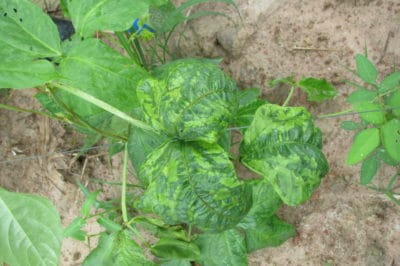What is Bean Mosaic?
In the western hemisphere, gardeners may need to deal with common, yellow and golden bean mosaic viruses. All result in patterned leaves that can vary from dark green to bright yellow or gold. These viruses can reduce yield and quality. The virus can overwinter in neighboring infected weeds and can also infect the seed itself.
Symptoms of Mosaic
Patterned leaves are the most common symptom of mosaic. The virus may also cause puckering of the leaf surface and the leaves may curl downward. Infected plants are often bushy and stunted. The bean pods may also be patterned and may be malformed. Infected plants may not set flowers or the flowers may not produce pollen. Infections are more likely to occur in warm weather.
Transmitting the Virus
Insects are one of the most common ways that mosaic viruses spread into the bean patch. Aphids, leafhoppers and whiteflies are known to spread mosaic. Humans can also spread the virus if it is present in containers or soil. If the virus is present in the sap of a bean plant, using trimmers or a knife that has been contaminated can cause an infection. Contaminated pollen is another possibility.
Mosaic-Resistant Varieties
Unfortunately, only a few varieties of polebeans available to gardeners are resistant to mosaic. They include:
- Blue Lake
- Kentucky Wonder
- Helda
Resistant bush beans are more numerous and include:
- Contender
- Green Crop
- Jade
- Provider
- Roma II
- Slenderette
- Tendercrop
- Valentino
Organic Controls
Controlling insect pests is one of the most important aspects of preventing mosaic diseases. Ladybug (ladybird beetles) will eat aphids. Neem and diatomaceous earth may also he helpful. Insecticidal soap and pepper or garlic sprays may keep insects from chewing on your bean plants. Floating row covers, applied immediately after planting and kept on until after flowering, can cut down on flying insects.
Prevention is Possible
Remove weeds, not only in the garden, but in adjoining areas if possible. Never save or use seed from infected crops. Wash your hands before and after working with plants. Disinfect tools, pots and greenhouse benches with a solution of one part bleach to four parts water. Don’t work in the garden when plants are wet. Don’t plant tobacco near susceptible plants (it can carry viruses) and never compost infected plants – burn them.
